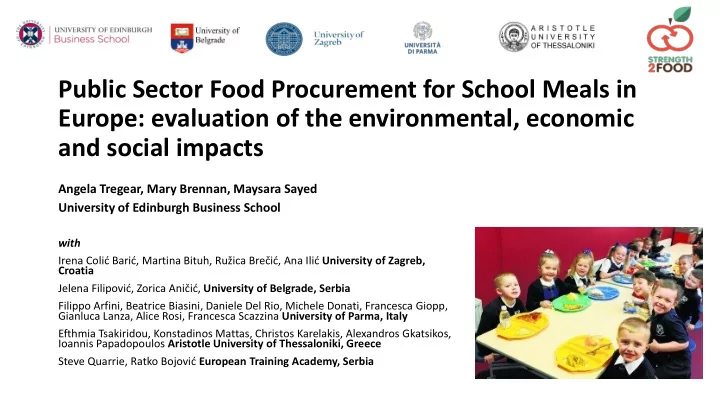

Public Sector Food Procurement for School Meals in Europe: evaluation of the environmental, economic and social impacts Angela Tregear, Mary Brennan, Maysara Sayed University of Edinburgh Business School with Irena Colić Barić, Martina Bituh, Ružica Brečić, Ana Ilić University of Zagreb, Croatia Jelena Filipovi ć, Zorica Aničić, University of Belgrade, Serbia Filippo Arfini, Beatrice Biasini, Daniele Del Rio, Michele Donati, Francesca Giopp, Gianluca Lanza, Alice Rosi, Francesca Scazzina University of Parma, Italy Efthmia Tsakiridou, Konstadinos Mattas, Christos Karelakis, Alexandros Gkatsikos, Ioannis Papadopoulos Aristotle University of Thessaloniki, Greece Steve Quarrie, Ratko Bojović European Training Academy, Serbia
Background to the Research Sustainable procurement… ‘low cost’ → ‘local/organic’ But what are impacts of different procurement models? Our research: case studies of 10 primary school meal services in 5 European countries, investigating: ➢ What are their carbon footprints? ➢ How much of the budgets stay in the local area? ➢ How are the relations between people in the chains? ➢ What’s on the menu and how nutritio us are the meals? ➢ How much food do children waste?
The Case Studies… CROATIA UK Zagreb (LOW & LOC) SERBIA Inverclyde (LOW) Belgrade Durham (LOC) Novi Sad (LOW & LOC) GREECE ITALY Thessaloniki (LOW) Parma (LOC-ORG) Kastoria (LOC) Lucca(ORG)
w hat was the carbon footprint of the case services? We measured emissions from: ➢ Production, processing and upstream transport of foods ➢ Downstream transport of foods, from wholesalers to kitchens/schools ➢ Waste disposal
First, which foods were purchased by the schools…? (kgs per average meal)
… and so what were the carbon footprints? (kgs C0₂e per average meal)
How much of the meals budgets stayed in their local areas? ➢ We tracked budget spend on staff and suppliers (local + non-local) ➢ We estimated how staff and suppliers respend that money (local + non-local)
How were school meals budgets spent…?
…so how much value was returned to local area? (1 = low; 3 = high) 2.46 2.37 2.50 2.28 2.28 2.25 160% 2.15 2.12 2.01 140% 1.89 2.00 120% 1.59 1.50 100% 80% 1.00 60% 40% 0.50 20% 0% 0.00 LOC LOW LOC LOW LOC LOW LOC-ORG ORG LOC LOW CROATIA SERBIA GREECE ITALY UK Local Staff Non-Local Staff Local Suppliers Non-Local Suppliers Other Direct Costs LM3
How good were relations between people in school meals chains/services?
• Relations between supply chain members, and between suppliers and schools, stronger in LOC cases than the LOW cases... ➢ ... Brings flexibility and resilience to supply chains, and educational/community benefits • In schools, mixed relations between catering and teaching staff… meals services often work in isolation from the rest of school life. ➢ To maximise social benefits, develop stronger connections between suppliers, the meals service and schools, and promote a more integrated role for catering staff
The School Canteens: What was on the menu and how nutritious were the meals? ➢ Food composition analysis of sample of daily menus
Chicken curry with rice or Tomato & basil pasta or Toasted sandwich or Baked potato
Nutritional Analysis of the Menus • High proportion of daily menus met standards for some nutrients, e.g. protein… • But many were deficient/excessive in others, e.g. energy, carbohydrates, total fat… • Nutritional quality dependent on: ➢ Implementing national standards framework ➢ Involving nutritionists in menu design
How much food was wasted? ➢ Plate waste collected from total of 179 lunch services
% of food served collected as plate waste • To reduce food waste: ➢ Valorise catering staff & environment ➢ Increase lunchtime supervision and support
Thank you for your attention! For more information: www.strength2food.eu
Recommend
More recommend